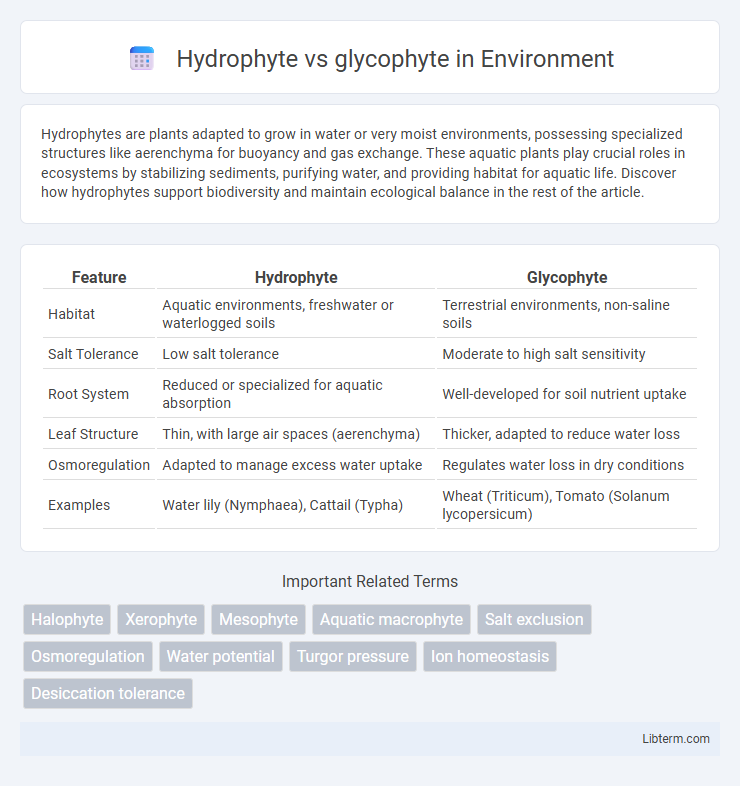Hydrophytes are plants adapted to grow in water or very moist environments, possessing specialized structures like aerenchyma for buoyancy and gas exchange. These aquatic plants play crucial roles in ecosystems by stabilizing sediments, purifying water, and providing habitat for aquatic life. Discover how hydrophytes support biodiversity and maintain ecological balance in the rest of the article.
Table of Comparison
| Feature | Hydrophyte | Glycophyte |
|---|---|---|
| Habitat | Aquatic environments, freshwater or waterlogged soils | Terrestrial environments, non-saline soils |
| Salt Tolerance | Low salt tolerance | Moderate to high salt sensitivity |
| Root System | Reduced or specialized for aquatic absorption | Well-developed for soil nutrient uptake |
| Leaf Structure | Thin, with large air spaces (aerenchyma) | Thicker, adapted to reduce water loss |
| Osmoregulation | Adapted to manage excess water uptake | Regulates water loss in dry conditions |
| Examples | Water lily (Nymphaea), Cattail (Typha) | Wheat (Triticum), Tomato (Solanum lycopersicum) |
Introduction to Hydrophytes and Glycophytes
Hydrophytes are aquatic plants adapted to grow in water-rich environments with specialized features like air-filled tissues for buoyancy and roots that absorb oxygen directly from water. Glycophytes are terrestrial plants that thrive in non-saline soils and lack salt tolerance mechanisms, making them sensitive to high salinity levels. Understanding the physiological and ecological distinctions between hydrophytes and glycophytes is essential for studies in plant adaptation and habitat specialization.
Defining Hydrophytes: Key Characteristics
Hydrophytes are plants adapted to grow in aquatic environments with high water availability, exhibiting features such as thin or absent cuticles, large air spaces (aerenchyma) for buoyancy and oxygen transport, and stomata located mainly on the upper leaf surfaces. These adaptations enable efficient gas exchange and prevent waterlogging, distinguishing hydrophytes from glycophytes, which are typical land plants adapted to lower water conditions with thicker cuticles and stomata on both leaf surfaces. Hydrophytes include species like water lilies, cattails, and hydrilla, which thrive in freshwater habitats or saturated soils.
Defining Glycophytes: Key Characteristics
Glycophytes are plants adapted to grow in soils with low salinity, exhibiting key characteristics such as salt sensitivity, freshwater dependence, and specialized physiological mechanisms to limit salt uptake and compartmentalize ions. Unlike hydrophytes that thrive in aquatic habitats with abundant water, glycophytes possess root structures optimized for terrestrial environments, ensuring efficient water absorption while preventing salt toxicity. These adaptations enable glycophytes to maintain cellular homeostasis and sustain growth under non-saline conditions, differentiating them from halophytic or aquatic plant species.
Habitat Differences: Where Hydrophytes and Glycophytes Thrive
Hydrophytes thrive in aquatic or water-saturated habitats such as ponds, lakes, and marshes, adapting to submerged or floating conditions with specialized tissues for oxygen transport. Glycophytes, on the other hand, are predominantly found in terrestrial environments with low salt concentration, including forests, grasslands, and agricultural fields, showing sensitivity to saline conditions. The key distinction lies in hydrophytes' salt tolerance and water abundance adaptations versus glycophytes' preference for well-drained, non-saline soils.
Morphological Adaptations of Hydrophytes
Hydrophytes exhibit distinct morphological adaptations such as thin, broad leaves with large air spaces (aerenchyma) that facilitate buoyancy and gas exchange in aquatic environments. Their roots are often reduced or absent, as water and nutrients are absorbed directly through stems and leaves. The presence of flexible stems enables hydrophytes to withstand water currents, distinguishing them significantly from glycophytes adapted to terrestrial habitats.
Morphological Adaptations of Glycophytes
Glycophytes exhibit morphological adaptations such as well-developed root systems with root hairs that enhance water absorption in low-salinity soils. Their leaf structures often feature thick cuticles and reduced stomatal density to minimize water loss through transpiration. Unlike hydrophytes, glycophytes possess specialized vascular tissues adapted for efficient water transport in terrestrial environments with varying moisture availability.
Physiological Mechanisms for Water and Salt Management
Hydrophytes exhibit specialized adaptations such as aerenchyma for efficient oxygen diffusion and thin cuticles to facilitate water absorption, enabling survival in aquatic environments with abundant water but low oxygen. Glycophytes regulate salt through selective ion transporters in roots and vacuolar compartmentalization that mitigate salt toxicity, maintaining cellular homeostasis in saline or non-saline soils. Both plant types employ root pressure and osmotic adjustment, but hydrophytes emphasize oxygen transport mechanisms, while glycophytes prioritize ion exclusion and salt sequestration to manage water and salt balance.
Ecological Roles and Importance
Hydrophytes, adapted to aquatic environments, play crucial ecological roles by stabilizing water ecosystems and providing habitats for diverse aquatic fauna. Glycophytes, thriving in non-saline soils, contribute to terrestrial ecosystem productivity by supporting nutrient cycling and serving as primary producers in various biomes. Both plant types influence biogeochemical cycles and maintain biodiversity within their respective habitats.
Economic and Agricultural Significance
Hydrophytes, such as rice and water chestnut, play a critical role in wetland agriculture and aquaculture economies due to their ability to thrive in water-saturated soils, enhancing food security in flood-prone regions. Glycophytes, including staple crops like wheat, maize, and soybeans, dominate global agriculture by favoring non-saline soils, thus underpinning major food production and commodity markets. Understanding the salt tolerance differences between hydrophytes and glycophytes informs crop selection and soil management strategies to optimize yield and sustainability in various agroecological zones.
Conclusion: Hydrophyte and Glycophyte Comparison
Hydrophytes thrive in aquatic or water-saturated environments with adaptations such as aerenchyma for oxygen transport, while glycophytes prefer non-saline soils and lack salt tolerance mechanisms. The key distinction lies in their ability to manage water and ion balance, with hydrophytes adapted to excess water conditions and glycophytes adapted to moderate soil salinity. Understanding these physiological and ecological differences is crucial for crop selection and habitat conservation strategies.
Hydrophyte Infographic

 libterm.com
libterm.com